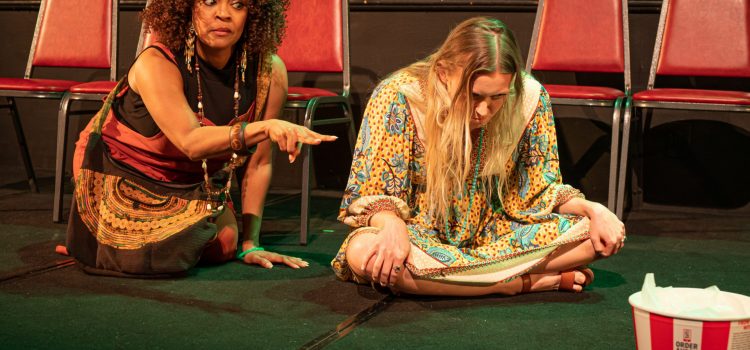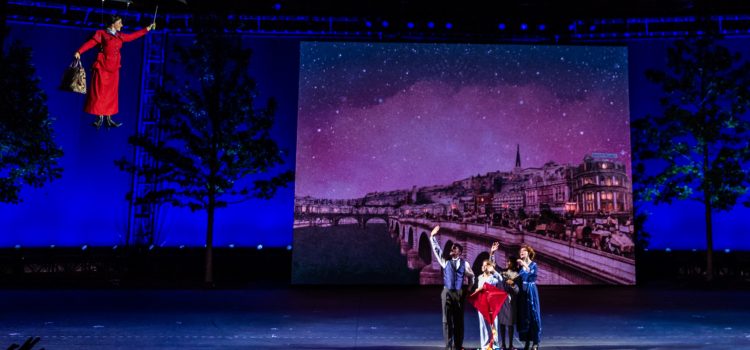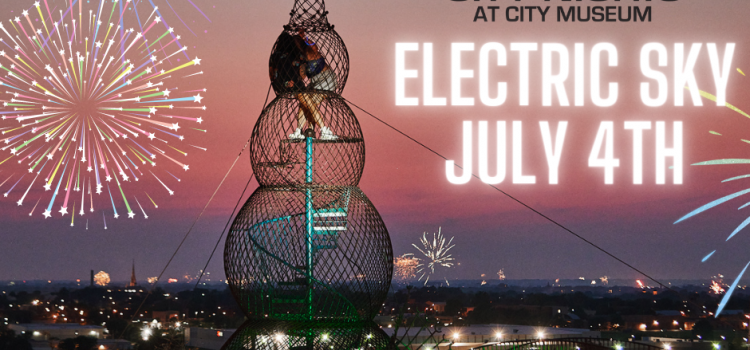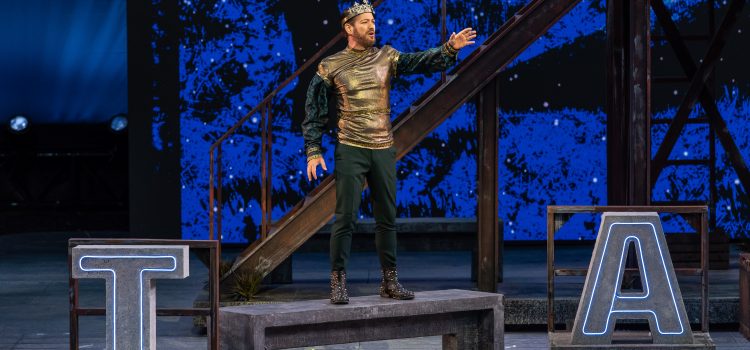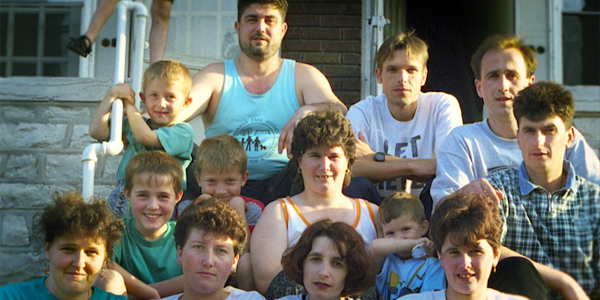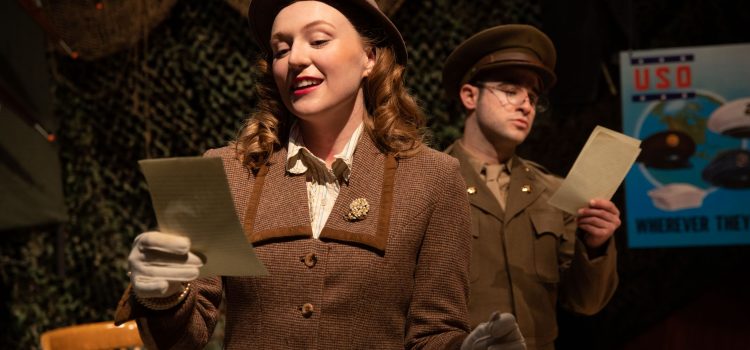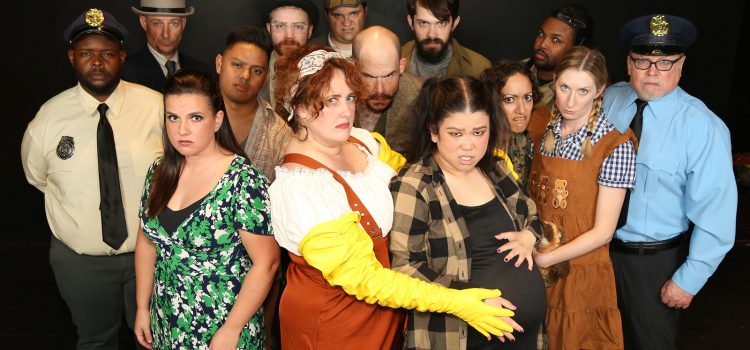By Lynn Venhaus
“Attention must be paid.”
In Fly North Theatrical’s hard-hitting “Assassins,” as the vainglorious actor John Wilkes Booth, a mesmerizing Jordan Wolk reminds us of those words, which were written by Arthur Miller in “Death of a Salesman” in 1949. With that, he connects these two commentaries on the American Dream.
This show, bending time and space, plunges us into a nightmare that we vividly recall but one, as the company makes clear, is no longer in the far-distant past.
Such is the unnerving grip of Stephen Sondheim’s 1990 musical, with book by John Weidman, based on a concept by Charles Gilbert Jr., as it delves into the twisted minds and violent motives of infamous criminals – four murderers and five would-be killers of U.S. presidents.
Weidman’s loose narrative features these footnotes in American history meeting, interacting, and inspiring each other in set pieces. He acknowledges the strange brew of celebrity culture colliding with deranged misfits, and Far North presents it with a raw, painful intimacy in the .Zack space.
This is Fly North’s first foray into presenting a classic landmark after offering original works in St Louis since 2017 (“The Gringo,” “Madam,” “Forgottonia.”)
The collaborative duo, music director and founder Colin Healy and director Bradley Rohlf, are at the helm, leading a creative team and cast that zealously dives into the deep end, uncompromising on the musical’s dark and disturbing nature. Its perspective is fresh, voices virtuoso and focus laser-like with minimal staging.
Lighting Designer Tony Anselmo’s work is outstanding, establishing an eerie mood through shadows and light. Costume designer Eileen Engel outfitted each character with period appropriate outfits, Healy created the sound design to add historical texture and Rohlf handled the projection design to enhance the visuals. Brian McKinley is the assistant director.
The .Zack has had some sound/microphone issues since it opened, and continues, in various degrees with an array of productions, but usually it affects musicals more than straight plays. In “Assassins,” some of the more intricate vocals are difficult to discern, but the singers project and enunciate with a lot of effort to overcome those moments, but it still happens. There is always this feeling, when you attend a show there, of “let’s hope the sound is OK.”
Thirty-two years after its off-Broadway premiere, this bold, ambitious, and revolutionary musical continues to haunt in a different way. It is one of those seminal works of the American theater, although at the time considered one of Sondheim’s least accessible. Interpretations change through the years, uniquely tapping into current political climates and realities.
The ensemble includes the mentally unstable killers of Presidents Abraham Lincoln, James Garfield, William McKinley, and John F. Kennedy, and would-be murderers of Franklin D. Roosevelt, Richard Nixon, Gerald Ford (two!) and Ronald Reagan.
Basically, mostly losers who wanted desperately to be winners, these are the little guys tired of being oppressed by the rich and powerful, railing against injustice. Or they’re just extremists on the fringe, American psychos craving attention.
In the jaundiced group number, “There’s Another National Anthem,” Sondheim wrote “For those who never win” — The ensemble sings: “No one listens.” and “Where’s my prize?”
As the Proprietor entices the group to fame and glory, sweet-voiced Eileen Engel sells the devastating “Everybody’s Got the Right” like a QVC barker — but no doubt would administer death penalty lethal injections or place a hangman’s noose with a big smile.
The seeds are planted for disaffected and alienated souls, and their insatiable need to be someone. The song, also used in the finale, is almost sinister in context by the end of the 100-minute one-act.
“Look at me!” “Attention must be paid!” (see also @prescon2022, which prepares future leaders, because #EverybodysGotTheRight to be president).
Healy and Rohlf were forced to delay their plans for this musical several times because of the coronavirus pandemic. But perhaps it couldn’t be a timelier presentation.
With razor-sharp cynicism, the clever, whip-smart creative team has produced a fully immersed take, transforming the .Zack into Prescon 2022 – you must get there early (half-hour before) to take part in “Tinfoil Hat Origami,” “Q, no A, with Marjorie Taylor Greene,” “White Collar Crime and How to Get Away With It” and “Tips and Tricks For a Perfect Rose Garden,” sponsored by Four Seasons Total Landscaping.
The run started during the Independence Day holiday weekend, at an unsettling time when political divisions are at a fever-pitch with nasty midterm campaigns heating up a summer of primaries, hearings, and mass shootings.
Of course, the musical was ahead of its time when the original off-Broadway production premiered at the Playwrights Horizons, and while still controversial, the acclaimed 2004 Roundabout revival on Broadway won five Tony Awards and a stripped down version was mounted off-Broadway by John Doyle in late 2021.
Rohlf’s re-imagining of the original carnival framing, a fairground shooting gallery, is a bull’s eye with the convention panel and recreation of vignettes, as narrated by The Balladeer, a riveting Stephen Henley, projecting melancholy and despair in a measured tone. He is the play’s soul.
As in other productions, The Balladeer performer transitions to play a conflicted Lee Harvey Oswald, and Henley imbues JFK’s assassin with a soul-crushing sadness. He is goaded into the deed by Booth, cunning in his persuasion while Oswald wrestles with his demons.
Sensitive to the issues of gun violence, Fly North uses mostly toy guns, but gunfire is used for the Kennedy assassination.
And it is jarring, and powerful, most effective in that one use, and leads up to the evocative and moving “November 22, 1963,” and “Something Just Broke,” which features Americans’ personal accounts from that day of infamy. The impact reverberated for years, as historians tell us, and anyone alive that day can recount in universal details about hearing the news and what it meant.
Such is the indelible Dealey Plaza in Dallas. And the Ford Theatre in Washington D.C., Bayfront Park in Miami, and parades, motorcades, and wherever death changed the course of history.
“Assassins” is not just the JFK-Oswald Special, nor is it all about Booth, but Lincoln’s assassin is a major catalyst. As written by Weidman, the Confederate sympathizer is embodied more dimensionally in Wolk’s fiery orations, starting with “The Ballad of Booth.”
On the evening of April 14, 1865, Booth entered the Ford Theatre’s presidential box, where Lincoln was watching the comedy “Our American Cousin,” in the third act, and shot him in the back of the head with a .44-caliber derringer. Lincoln died the next morning. Booth escaped with another conspirator, David Herold, and they fled to a barn in Virginia, where they were finally cornered. Herold gave himself up, but Booth refused to surrender and was fatally shot by a police officer. He died on April 26, at age 26.
The show features other characters we may not know much about beyond their names. The bizarre cases of two women, who both attempted to shoot President Gerald Ford within three weeks of each other in California in 1975, are played for laughs — only they are not in on the joke.. While dark, the ineptness and the looney-tunes perception of Charles Manson follower Lynette “Squeaky” Fromme and accountant-turned-hothead Sara Jane Moore is further enhanced by the manic performances of Avery Lux and Kimmie Kidd-Booker.
Lux portrays the brainwashed cultist believing Manson is the son of God and savior of the world as a woman not tethered to any reality while Kidd-Booker depicts easily agitated Moore as a loose cannon. Weidman has used creative liberties here in teaming up the unstable women.
Fromme was first, and the Manson Family mainstay, on Sept. 5, 1975, in Sacramento’s Capitol Park, was hoping to talk to President Ford about the redwoods. Armed with a Colt semi-automatic pistol that had four rounds, she aimed at Ford but there was no bullet in the magazine chamber and was immediately apprehended by Secret Service. She was 26 and received life imprisonment, paroled in 2009 after serving 34 years.
Moore, 45, had 113 rounds of ammunition when she fired a single bullet at President Ford, who was about 40 feet away, and uninjured, while she was in a crowd across the street from the St. Francis Hotel in San Francisco. Moore later admitted to radical political views and expressed regret. She served 32 years of a life sentence and was released on parole in 2007, at age 77.
As one of the three would-be assassins not killed, Jaymeson Hintz portrays John Hinckley Jr. as a pathetic mentally ill young man who had an unhealthy obsession with actress Jodie Foster, then a student at Yale. At age 25, in Washington D.C., he shot President Reagan . on March 30, 1981. With a .22 caliber revolver, he also wounded police officer Thomas Delahanty and Secret Service agent Tim McCarthy. Press Secretary James Brady was left permanently disabled in the shooting.
Hinckley was found not guilty by reason of insanity and spent over three decades in psychiatric care. He is now released.
His duet with Fromme, “Unworthy of Your Love,” is one of Sondheim’s most heart-breaking ballads.
As the meeker but fixated marksman, Hintz holds his own on stage with the showier roles. He nails Hinckley’s schizoid personality disorder, among other diagnoses. Hintz also has some fun acting as bumbling President Ford.
This musical is not constructed to be a documentary, so the historical figures are shaped by their known backstory but in a more snapshot-type way than a History Channel recap.
Attorney Charles J. Guiteau is portrayed by Bradley Rolen as a delusional gasbag whose increasingly grandiose ramblings are dismissed as nonsense. He considered himself a “Stalwart,” the “Old Guard” faction of the Republican party, supporting Chester A. Arthur, then vice president. He purchased a gun he “thought would look good in a museum,” and followed President James A. Garfield several times, losing his nerve until destiny happened at a train station.
On the morning of July 2, 1881, as the 20th leader of our country departed for New Jersey, Guiteau shot him twice with a revolver. Garfield had only been president for three months when he died Sept. 19, from complications attributed to his doctors, and Guiteau was executed by hanging the next June. He was 40.
“The Ballad of Guiteau” and the chilling “The Gun Song” are part of his repertoire – “pull the trigger, change the world.”
After his second inauguration, the 25th president, William McKinley, another Ohioan, embarked on a six-week tour of the nation. Stopping in Buffalo, New York, to greet people at the Pan-American Exposition Hall’s Temple of Music on Sept. 6, 1901, disgruntled factory worker Leon Czolgosz concealed a handgun in a handkerchief.
The young laborer had become disillusioned by the country’s economic and social turmoil, later involved with a radical socialist group and influenced by anarchist Emma Goldman. Speaking with a Polish accent, Eli Borwick channels that anger and frustration in his powder-keg reactions.
When Czolgosz made it to the front of the line, he shot McKinley twice in the abdomen at close range. The president died a week later. Caught in the act, Czolgosz was quickly tried, convicted, and executed in an electric chair seven weeks later. He was 28.
Borwick’s bombast suits the character, particularly in his songs “The Gun Song” and “The Ballad of Czolgosz.”
As troubled Italian immigrant Guiseppe Zangara, Ryan Townsend conveys the bricklayer’s severe abdominal pain, which in his autopsy was attributed to adhesions on his gallbladder, but he had never received relief in life, even after an appendectomy.
Zangara attempted to kill president-elect Franklin D. Roosevelt during a night speech in Miami, 17 days before his inauguration, on Feb. 15, 1933. He shot a .32 caliber pistol five times but missed Roosevelt, striking four others.
Without remorse, when taken to the Dade County Courthouse, he said: “I kill kings and presidents first and next all capitalists.”
He was charged with their attempted murders, but when a victim, Chicago Mayor Anton Cermak, died 19 days later from peritonitis, Zangara was upgraded to a first-degree murder charge and sentenced to death. He was electrocuted in the Florida State Prison’s electric chair, nicknamed “Old Sparky,” at age 32.
Townsend uses a thick accent that sometimes makes it hard to understand his rants. He’s part of “How I Saved Roosevelt” and group numbers, displaying a strong voice.
One of the more amusing portrayals is Sarah Lantsberger as Sam Byck, who really thought he would be a hero if he hijacked a plane and flew it into the White House in hopes of killing the much-despised Nixon. On Feb. 22, 1974, he put his plan into motion – trying to hijack a plane flying out of the Baltimore/Washington International Airport, but during the bungled incident, he killed a policeman and a pilot. He was then shot by another policeman and turned the gun on himself, death by suicide.
In two scenes, Byck is shown taping his diatribes, one to Leonard Bernstein (?!) – which can get very meta, connecting Sondheim’s contributions to “West Side Story”, and another to Nixon. Lantsberger commits to earnestly delivering his grievances. She also portrays Emma Goldman in scenes with Borwick..
Of note are Trey Marlette as a Secret Service agent and Layla Mason as Billy, Sara Jane Moore’s son that she brings along to the crime scene.
The vocals are exceptional, and the 11-piece band smoothly covers the complexities of Sondheim’s score that mixes tones and genres. Ryan Hinman, keyboards, Nicki Evans keyboards, Adam Lugo guitar, Teddy Luecke bass, Des Jones percussion, Lucille Mankovich reeds, Linda Branham Rice reeds, John Gerdes horn, Ron Foster trumpet, Joe Akers trumpet, and Adam Levin trombone, led by conductor Healy, are superb.
The ever-inventive Sondheim, whose brilliance encompassed writing lyrics of irony, emotional pain, humanity’s foibles and hunger for connection, has penned some of his most perturbing ones on our inalienable rights here. And now, after his passing in November, his words resonate from beyond the grave. “Made me wonder who we are” — “Something Just Broke.”
With the political chaos of the past decade and continued death threats against our political leaders and public servants, we have yet to fully comprehend the “Twilight Zone”-like reality that is life in 2022. After all, seditionists and malcontents tried to thwart democracy and nearly hung the vice president last year.
And after this show opened, a 22-year-old loner — who legally obtained five guns despite the ‘red flag laws,’ ripped a community apart from a rooftop as it was celebrating our 246th Independence Day.
This cogent “Assassins” certainly gives one pause about the current state of the union — If it doesn’t raise the hair on your arms, you are not paying attention.
After all, “Attention must be paid”!

Fly North Theatricals presents “Assassins” from July 1 through July 23, with a special July 4 show at 4 p.m. for $17.76. Other performances are Thursday through Saturday at 7:30 p.m. July 7-9, July 14-16 and July 21-23, with Sunday matinees at 2 p.m. July 3, 10, and 17 at the .Zack building, It runs 100 minutes and is presented in one act without an intermission. The show contains strong language, use of a racial slur as well as the use of prop firearms in the house in proximity to audience members. For more details, refer to the content warnings – which contains spoilers. For tickets, visit www.MetroTix.com and for more information, visit the website, www.flynorththeatricals.com

